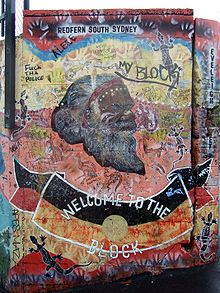The Block (Sydney)
This article needs additional citations for verification. (August 2015) |

The Block is a colloquial but universally applied name given to a residential block of social housing in the suburb of Redfern, Sydney, bound by Eveleigh, Caroline, Louis and Vine Streets. Beginning in 1973, houses on this block were purchased over a period of 30 years by the Aboriginal Housing Company (AHC) for use as a project in Aboriginal-managed housing.
The Block is probably the most famous feature of the suburb of Redfern, although it is located on the western border of that suburb, on the edge of Darlington. The focus of life in the Block has always been Eveleigh Street, which is its eastern border, with railway lines on the other side of that street. The Block is in the immediate vicinity of Redfern station.
The area around The Block is now reportedly the subject of plans for massive redevelopment by private developers at the instigation of the New South Wales state government (see Redfern-Eveleigh-Darlington).
1972 transfer to the Aboriginal Housing Company[]
In 1965, Charles Perkins and Reverend Ted Noffs of the Wayside Chapel organised a Freedom Ride with 30 white Sydney University students from the group Student Action for Aborigines (SAFA). This inspired Koori political activists, awakened positive media interest and commenced an era of protests.
The Block has historically been the subject of large protests, starting in the early 1970s, when landlords in the area conducted a campaign of evicting all Aboriginal residents. A group of campaigners, led by future judge Bob Bellear, successfully lobbied the Whitlam government for a grant which allowed the AHC to commence purchasing houses in 1972. The area was significant as an affordable source of low-cost housing for disadvantaged Aboriginal people.
As a pioneering and still unique project in Aboriginal-run housing near the centre of Australia's largest city, it excites enormous emotions, and moreover is viewed by the largely rural Indigenous population of New South Wales as a pied-à-terre and spiritual home in Australia's largest city.[citation needed] For non-Aboriginal people, The Block has assumed a notorious reputation for violence and crime.[1]
In 2004, the Aboriginal Housing Company decided to raze part of The Block that had deteriorated into a slum.[2]
2004 Redfern riot[]
On 14 February 2004, The Block was the scene of 2004 Redfern riots following the death of an Australian Aboriginal boy, TJ Hickey. Hickey died after, while on bike, he collided with a protruding gutter, was flung into the air and was impaled on a 2.5-metre-high fence outside a block of units off Phillip Street, Waterloo, possibly whilst being followed by police.
Hickey was transported from the scene to the Sydney Children's Hospital in a critical but stable condition. He died with his family by his side on 15 February due to the severity of his wounds.[3]
Post riot[]
The present Redfern railway station was damaged by fire in the 2004 Redfern riots. The ticketing area and station master's office were significantly damaged - and the windows in the front of the station were bricked up for almost a year afterwards to prevent further attacks. They have since been replaced with glass windows. The AHC's plan for the redevelopment of The Block, known as The Pemulwuy Project, has been met with some opposition by the State Government.[4]
References[]
- ^ Malkin, Bonnie (20 September 2010). "Sydney's notorious Aboriginal ghetto to be demolished". The Telegraph. ISSN 0307-1235. Retrieved 24 November 2018.
- ^ Corvini, Danny (8 January 2014). "Redfern now: from no-go to 'can't stay away'". The Sydney Morning Herald. Archived from the original on 8 January 2014. Retrieved 24 November 2018.
- ^ "Report by the NSW State Coroner into deaths in custody / police operations 2006" (PDF). State Coroner’s Office, NSW Attorney General’s Department. 2006: 71. ISSN 1323-6423. Cite journal requires
|journal=(help) - ^ "Aboriginal Housing Company - redevelopmewnt news". Archived from the original on 18 July 2008.
Further reading[]
External links[]
- The Block, Four Corners transcript 12/05/97
- The Block: Stories from a Meeting Place SBS interactive documentary
- Sydney localities
- Indigenous Australian politics
- Indigenous Australians in New South Wales
- Redfern, New South Wales
- Indigenous Australian communities
